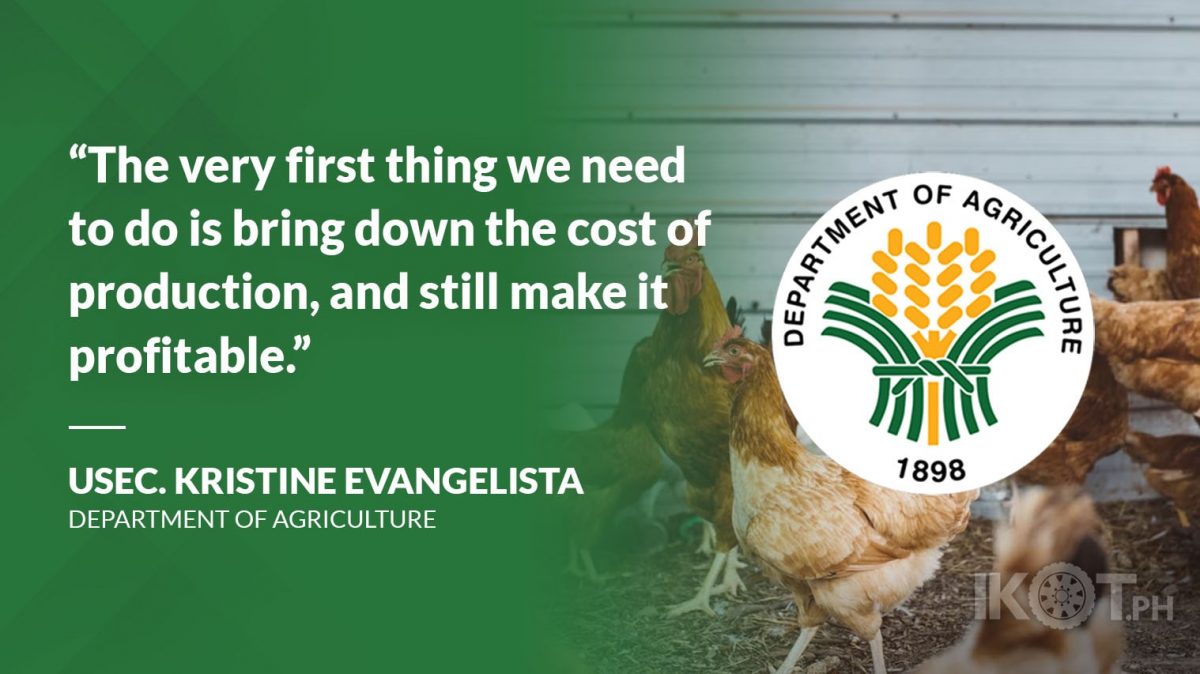To address current challenges faced by the poultry sector, particularly the imbalanced demand and supply ratio for chicken meat and egg, the Department of Agriculture (DA) through the Bureau of Animal Industry (BAI) met with industry stakeholders recently.
Undersecretary Kristine Evangelista explained that the meeting was called to discuss strategies to bring down the cost.
“The very first thing we need to do is bring down the cost of production, and still make it profitable to encourage our stakeholders to continue producing amidst the challenges in the sector,” Evangelista said.
During the discussions, BAI reported that it has monitored a relative decrease in the overall volume of production due to a host of factors.
According to BAI Director Reildrin Morales, this is attributed to the opening up of the market, thus increasing demand against a production level geared towards a lockdown scenario.
Data from the National Meat Inspection Service (NMIS) show that 346 million poultry heads were slaughtered from January to June 2021 —when “lockdown” is being implemented in various parts of the country —as compared to 2022 data of 349 million poultry heads slaughtered.
“Subject to further analysis of disposable household income, the 2021 slaughter data catering to 2022 needs where there has been the opening of markets, such as hotels, restaurants and other institutional buyers, shows obvious discrepancy against available supply,” Morales said.
“Some producers held back production thinking that Avian Influenza, Inclusion Body Hepatitis, and other diseases would keep markets closed.”
Apart from the spike in demand, BAI reported that some producers held back production thinking that Avian Influenza (AI), Inclusion Body Hepatitis (IBH), and other diseases would keep markets closed.
“Other factors that have resulted in the disparity in supply and demand are the rising cost of inputs such as feed ingredients and fuel, the changing weather conditions and nutritional formulation adjustment of companies that led to stunted growths and prolonged growing periods of poultry birds,” he explained.
To address these aforementioned challenges, BAI, together with industry stakeholders, recommended the firming up of Life Cycle Model (LCM) to ascertain the current supply.
According to Morales, current LCM on both layer and broiler chicken may not be reflective of the actual situation as there have been some ‘interventions’ made by importer-producers of breeder stocks for both layer and broilers due to AI.
An intensified early reporting of farmers was also recommended, with a call for an increase in indemnification value and shortened process of indemnification for affected birds.
“The BAI should consider streamlining the indemnification process to enable the affected growers to immediately resume production and recover.”
According to United Broilers Raisers Association president Elias Jose Inciong, the BAI should consider streamlining the indemnification process to enable the affected growers to immediately resume production and recover.
It was also suggested that the Price and Volume Watch be revived, along with the Local Price Monitoring Council, to monitor the prices of affected commodities and prevent value overshoot.
During the meeting, concerns about the proposed permanent lowering of tariffs on imported poultry products were raised.
“It would be best if DA can come up with clear policies on proposed tariff on meat, to firm up the confidence of farmers and producers,” Inciong said.
It was also suggested that DA and the Department of Interior and Local Government harmonize and unify policies with regard to the movement guidelines of live birds, poultry products, and by-products during the Avian Influenza outbreak.
Amid reports of a supply shortfall, the DA-BAI is looking forward to a sufficient supply of pork and poultry products for the rest of the year.
Based on the 2022 food supply outlook, the total supply of poultry will reach 580,415 metric tons (MT) for the third quarter and 610,696 MT for the fourth quarter, with total demand of 405,017 MT and 435,100 MT respectively.
“Poultry self-sufficiency ratio will remain at 92% by the end of the year, with an ending stock of 175,596 MT good for 39 days,” Morales said.


